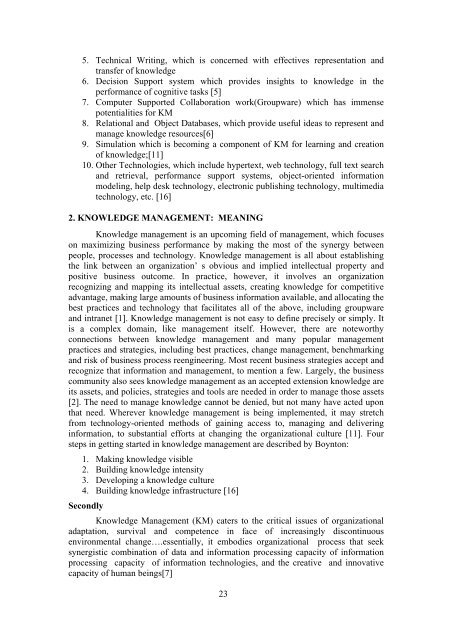READIT-2007 - Indira Gandhi Centre for Atomic Research
READIT-2007 - Indira Gandhi Centre for Atomic Research
READIT-2007 - Indira Gandhi Centre for Atomic Research
Create successful ePaper yourself
Turn your PDF publications into a flip-book with our unique Google optimized e-Paper software.
5. Technical Writing, which is concerned with effectives representation and<br />
transfer of knowledge<br />
6. Decision Support system which provides insights to knowledge in the<br />
per<strong>for</strong>mance of cognitive tasks [5]<br />
7. Computer Supported Collaboration work(Groupware) which has immense<br />
potentialities <strong>for</strong> KM<br />
8. Relational and Object Databases, which provide useful ideas to represent and<br />
manage knowledge resources[6]<br />
9. Simulation which is becoming a component of KM <strong>for</strong> learning and creation<br />
of knowledge;[11]<br />
10. Other Technologies, which include hypertext, web technology, full text search<br />
and retrieval, per<strong>for</strong>mance support systems, object-oriented in<strong>for</strong>mation<br />
modeling, help desk technology, electronic publishing technology, multimedia<br />
technology, etc. [16]<br />
2. KNOWLEDGE MANAGEMENT: MEANING<br />
Knowledge management is an upcoming field of management, which focuses<br />
on maximizing business per<strong>for</strong>mance by making the most of the synergy between<br />
people, processes and technology. Knowledge management is all about establishing<br />
the link between an organization’ s obvious and implied intellectual property and<br />
positive business outcome. In practice, however, it involves an organization<br />
recognizing and mapping its intellectual assets, creating knowledge <strong>for</strong> competitive<br />
advantage, making large amounts of business in<strong>for</strong>mation available, and allocating the<br />
best practices and technology that facilitates all of the above, including groupware<br />
and intranet [1]. Knowledge management is not easy to define precisely or simply. It<br />
is a complex domain, like management itself. However, there are noteworthy<br />
connections between knowledge management and many popular management<br />
practices and strategies, including best practices, change management, benchmarking<br />
and risk of business process reengineering. Most recent business strategies accept and<br />
recognize that in<strong>for</strong>mation and management, to mention a few. Largely, the business<br />
community also sees knowledge management as an accepted extension knowledge are<br />
its assets, and policies, strategies and tools are needed in order to manage those assets<br />
[2]. The need to manage knowledge cannot be denied, but not many have acted upon<br />
that need. Wherever knowledge management is being implemented, it may stretch<br />
from technology-oriented methods of gaining access to, managing and delivering<br />
in<strong>for</strong>mation, to substantial ef<strong>for</strong>ts at changing the organizational culture [11]. Four<br />
steps in getting started in knowledge management are described by Boynton:<br />
1. Making knowledge visible<br />
2. Building knowledge intensity<br />
3. Developing a knowledge culture<br />
4. Building knowledge infrastructure [16]<br />
Secondly<br />
Knowledge Management (KM) caters to the critical issues of organizational<br />
adaptation, survival and competence in face of increasingly discontinuous<br />
environmental change….essentially, it embodies organizational process that seek<br />
synergistic combination of data and in<strong>for</strong>mation processing capacity of in<strong>for</strong>mation<br />
processing capacity of in<strong>for</strong>mation technologies, and the creative and innovative<br />
capacity of human beings[7]<br />
23

















